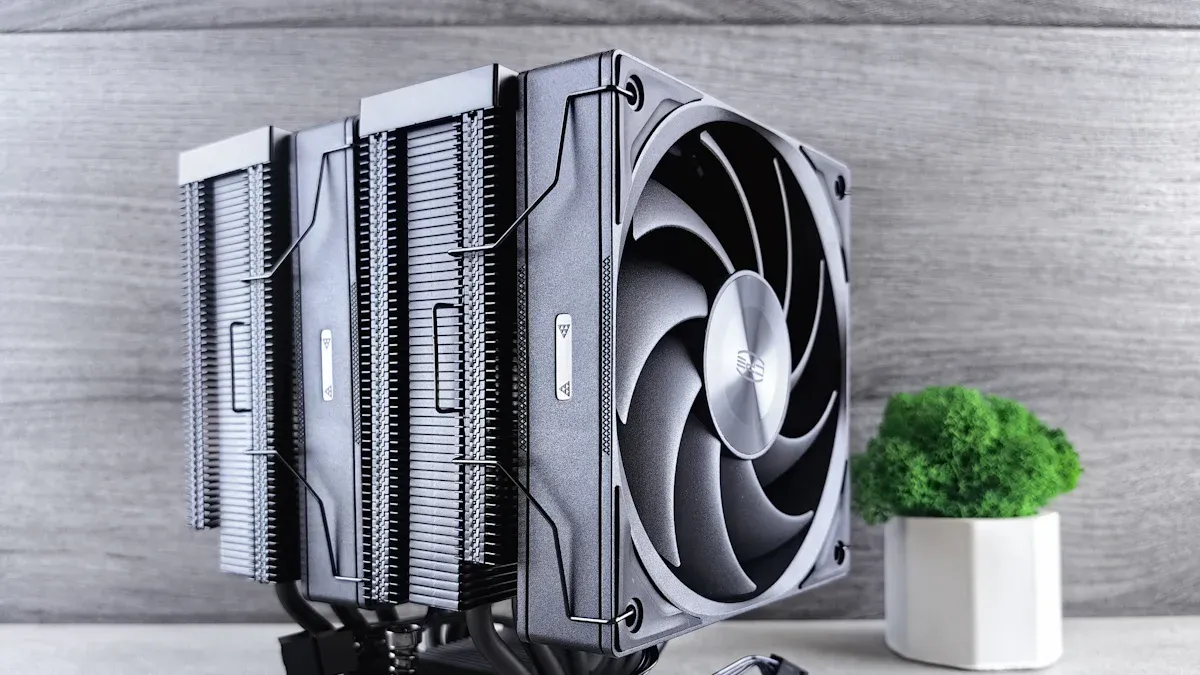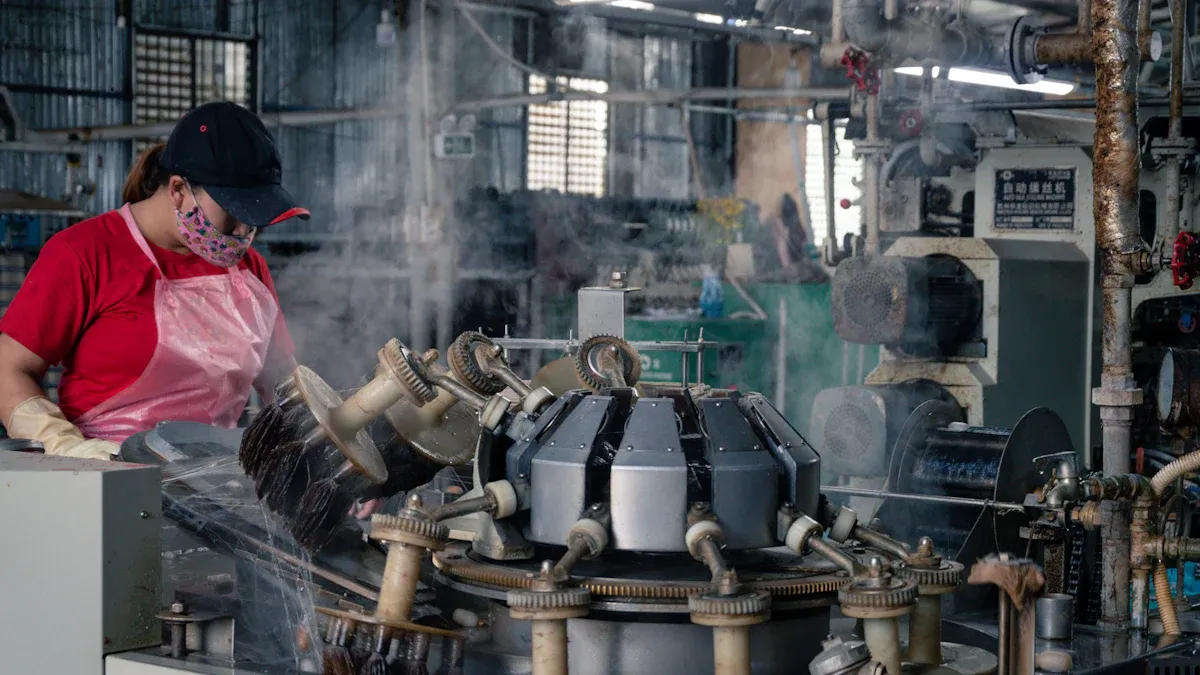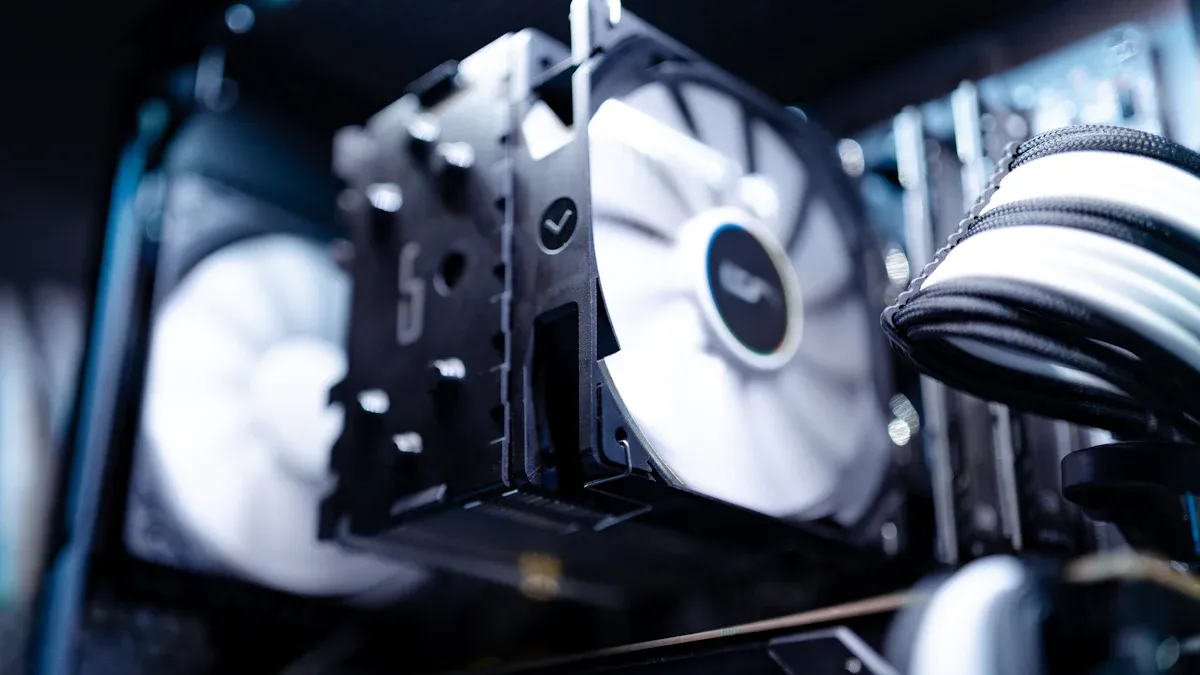
Efficient mold cooling optimization plays a critical role in speeding up production. By improving cooling efficiency, you can significantly reduce the cycle time of your injection molding process. This phase, which often consumes the most time in the production cycle, directly impacts how quickly you can deliver products. Even a 15% reduction in cooling time can lead to noticeable improvements in production efficiency. Faster cooling not only boosts output but also ensures consistent product quality, helping you meet your production goals more effectively.

Cooling is the longest phase in the injection molding cycle time. It directly determines how quickly you can produce parts. By improving cooling efficiency, you can significantly reduce cycle times and boost production efficiency. For example, conformal cooling methods can reduce cycle times by up to 24% compared to conventional cooling.
| Cooling Method | Cycle Time (s) | Reduction (%) |
|---|---|---|
| Conventional Cooling | 17 | N/A |
| Conformal Cooling | 13 | 24 |
Efficient cooling ensures that the mold temperature is controlled, allowing the plastic to solidify faster. This leads to shorter cooling times and faster production cycles.
Efficient cooling not only reduces cycle time but also improves product quality. Poor cooling can lead to defects like sink marks, warpage, or stress fractures. For instance, a 10°C temperature imbalance during cooling can cause stress fractures, increasing downtime and repair costs.
| Evidence | Impact |
|---|---|
| 15% energy savings | Improved efficiency and reduced costs |
| Reduce cycle times by up to 30% | Increased throughput and productivity |
| Higher scrap rates due to poor cooling | Decreased product quality and increased costs |
| 10°C temperature imbalance leads to stress fractures | Increased downtime and repair costs |
By maintaining uniform cooling, you can minimize defects and ensure dimensional accuracy. Advanced cooling solutions, such as conformal cooling, also help reduce energy usage by up to 25%, making the process more sustainable.
The cooling phase begins as soon as the molten plastic enters the mold. The plastic cools upon contact with the mold surface, hardening into the desired shape. During this phase, coolant flows through channels in the mold to remove heat efficiently.
| Step | Description |
|---|---|
| Cooling Start | As soon as the molten plastic hits the mold, it begins to cool. |
| Solidification | The mold cannot be opened until the product is solidified to prevent deformation. |
| Coolant Use | Coolant can be pumped through the mold channels to expedite cooling. |
Efficient cooling requires proper flow management and clean coolant channels. Turbulent flow in the channels enhances heat transfer, reducing cooling time and improving injection molding cycle time. By optimizing this phase, you can achieve faster cycle times and better product quality.
Understanding the factors that influence cooling efficiency is essential for improving the injection molding process. By addressing these factors, you can achieve faster cycle times, better product quality, and higher production efficiency.
The material type and properties of the mold play a critical role in cooling efficiency. Materials with high thermal conductivity transfer heat more effectively, reducing cooling time. For example, conventional tool steels typically have a thermal conductivity range of 12-20 Btu/(hr•ft⋅°F). In contrast, high-conductivity steels can reach up to 35 Btu/(hr•ft⋅°F), significantly improving cooling rates and minimizing warpage issues.
Other material properties, such as specific heat and density, also affect cooling performance. Specific heat determines how quickly the mold absorbs heat from the molten plastic, while density impacts the overall thermal behavior of the mold. Selecting the right material for your mold ensures efficient cooling and shorter injection molding cycle times.
| Factor | Description |
|---|---|
| Mold Material Properties | Different grades of mold materials have varying thermal properties affecting cooling efficiency. |
| Thermal Conductivity | Essential for heat transfer; higher conductivity leads to reduced cooling times. |
| Specific Heat | Influences how quickly the mold can absorb heat from the molten plastic. |
| Density | Affects the overall thermal performance of the mold material. |
By choosing materials with optimal thermal properties, you can enhance cooling efficiency and achieve better results in your injection molding process.
The design of the mold and the layout of cooling channels are among the most important factors affecting cooling time. Cooling channels must be strategically placed to ensure uniform heat removal. Advanced techniques, such as conformal cooling, use curved cooling circuits that align with the mold cavity's shape. This design minimizes temperature variations, reduces warpage defects, and shortens cycle times.
Case studies highlight the effectiveness of optimized cooling channel layouts. For instance, finite element analysis (FEA) has been used to identify the best locations for cooling channels, improving thermo-mechanical performance and reducing injection molding cycle time. Machine learning techniques have also been applied to design cooling channels that minimize surface temperature variations.
| Evidence Description | Methodology Used | Key Findings |
|---|---|---|
| Optimal layout of cooling channels assessed using temperature deviation | Design of experiments and trade-off techniques | Achieved best thermo-mechanical performance through optimal design configurations |
| FEA thermal analysis for optimal cooling channel locations | Finite Element Analysis (FEA) | Identified locations to reduce cycle time and improve mold quality |
| Machine learning for cooling channel topology based on part specifications | Machine Learning | Developed a surrogate model to minimize surface temperature variations |
By focusing on mold design and cooling channel layout, you can achieve cooling efficiency optimization and improve the overall injection molding process.
Process parameters and temperature control directly impact cooling efficiency. Factors such as coolant flow rate, water temperature, and pressure must be carefully managed to optimize heat transfer. For example, higher coolant flow rates improve heat removal, while maintaining an optimal water temperature prevents slow cooling.
Simulation studies have shown that adjusting process parameters by as little as 5% can significantly affect energy flow and cooling system performance. Tools like p-h diagrams help analyze the relationship between pressure and specific enthalpy, providing insights into system efficiency. By fine-tuning these parameters, you can achieve faster cooling and reduce injection molding cycle time.
| Evidence Type | Description |
|---|---|
| Control Parameters | The relationship between control parameters and system performance is analyzed, focusing on the coefficient of performance (COP) and thermophysical properties of refrigerants. |
| p-h Diagram | The p-h diagram illustrates the relationship between pressure and specific enthalpy, which is essential for determining cooling system performance. |
| Simulation Results | The simulation involves varying parameters by up to 5% relative to predicted values, allowing for the exploration of energy flow and efficiency in the cooling system. |
Effective temperature control and process optimization ensure efficient cooling, leading to better product quality and shorter cycle times.

Reducing cooling time is essential for improving the efficiency of your injection molding process. By adopting advanced cooling systems and optimizing mold design, you can achieve faster cycle times and better product quality. Below are some proven techniques to reduce cooling time effectively.
Advanced cooling systems play a crucial role in enhancing cooling efficiency and reducing cycle time. These technologies focus on improving heat transfer and ensuring uniform cooling throughout the mold. Here are some of the most effective cooling techniques:
Studies show that advanced cooling systems can increase the average coefficient of performance by 18% and improve efficiency by 41% during high cooling demand. Additionally, energy savings predictions indicate a 13% reduction in energy bills by 2023. These technologies not only reduce cooling time but also make the injection molding process more sustainable.

The design of cooling channels significantly impacts cooling efficiency and cycle time. Optimized cooling channel design ensures effective heat removal and uniform temperature distribution across the mold. Here’s how you can achieve this:
Research highlights that optimized cooling channel design can significantly reduce cycle times by improving heat transfer efficiency. For example, thermal flow simulations and finite element analysis (FEA) have been used to identify the best cooling channel configurations, leading to quicker production cycles and better mold quality.
Selecting materials with high thermal conductivity is another effective way to reduce cooling time. These materials enhance heat dissipation, ensuring efficient cooling even in narrow mold sections. Consider the following options:
Materials with thermal conductivity ranging from 15 W/mK to over 150 W/mK are ideal for achieving efficient cooling. By using these materials, you can maintain uniform surface temperatures and optimize the injection molding process.
Tip: Always evaluate the thermal properties of mold materials before finalizing your design. High-conductivity materials not only reduce cooling time but also improve overall mold performance.
By combining advanced cooling systems, optimized cooling channel design, and high-conductivity materials, you can achieve significant improvements in cooling efficiency and cycle time. These techniques ensure faster production cycles and better product quality, making them essential for any injection molding operation.
Adjusting your injection molding process can significantly reduce cooling time and improve production efficiency. By fine-tuning specific parameters, you can optimize heat transfer and achieve faster cycle times. Below are some key adjustments to consider:
| Adjustment | Impact on Cooling Performance |
|---|---|
| Optimizing cooling time | Prevents premature ejection and deformation of parts while maintaining efficiency. |
| Control of mold temperature | Ensures effective cooling and reduces cycle times by maintaining optimal thermal conditions. |
| Understanding thermal properties | Allows for better regulation of cooling processes based on material characteristics. |
Tip: Use process monitoring tools to track mold temperature and cooling time. These tools help you identify inefficiencies and make real-time adjustments for better results.
By implementing these adjustments, you can reduce cooling time and improve the overall efficiency of your injection molding process.
Regular maintenance of your cooling systems is essential for sustaining optimal performance. Neglecting maintenance can lead to clogged channels, reduced heat transfer, and longer cycle times. Here are some best practices for maintaining your cooling systems:
Note: Investing in automated monitoring systems can simplify maintenance. These systems alert you to potential issues, allowing you to address them before they impact production.
Proper maintenance not only improves cooling efficiency but also reduces the risk of unexpected breakdowns. A well-maintained cooling system ensures consistent performance, helping you achieve faster cycle times and better product quality.
Optimizing mold cooling offers significant advantages, particularly in reducing cycle times and cutting costs. Faster cycle times directly enhance production efficiency in injection molding. By shortening the cooling time, you can produce more parts in less time, increasing throughput and profitability. For example, modern HDPE injection molding machines achieve cycle times as short as 8-12 seconds, reducing energy consumption and machine wear.
Shorter cycle times also lead to measurable cost savings. Businesses can achieve a 20-30% overall cost reduction by implementing strategies for reducing cycle times. These savings stem from lower energy usage per part and reduced operational expenses. Additionally, advanced cooling techniques like conformal cooling and computational fluid dynamics (CFD) simulations improve cooling efficiency, further enhancing cost-effectiveness.
Did you know? Faster cycle times not only save costs but also reduce the environmental impact of injection molding by lowering energy consumption.
While the benefits of mold cooling optimization are clear, challenges such as high implementation costs and maintenance requirements can arise. For instance, using high-conductivity materials like copper improves cooling rates but increases material costs. Similarly, adopting advanced cooling techniques, such as conformal cooling, requires specialized equipment and expertise, which can elevate initial investment.
Maintenance is another critical consideration. Cooling systems require regular upkeep to sustain performance. Neglecting maintenance can lead to clogged channels, reduced heat transfer, and longer cycle times. Strategies for reducing cycle times, such as lowering melt temperature or decreasing pressure holding time, can help minimize maintenance needs. For example, reducing thermal stress by lowering melt temperature decreases wear on molds, extending their lifespan.
| Optimization Strategy | Impact on Costs and Maintenance |
|---|---|
| Reducing cooling time | Lowers operational costs and minimizes cooling system wear. |
| Lowering melt temperature | Reduces thermal stress, decreasing maintenance frequency. |
| Decreasing pressure holding time | Prevents excessive material packing, reducing mold wear and maintenance costs. |
| Elevating mold temperature | Promotes uniform cooling, enhancing mold longevity and reducing maintenance needs. |
Balancing these challenges with the benefits requires careful planning. By evaluating your production needs and adopting tailored strategies for reducing cycle times, you can maximize the advantages of mold cooling optimization while managing costs effectively.
Optimizing mold cooling is essential for faster production and improved efficiency in injection molding. By reducing cooling time, you can achieve shorter cycle times, better product quality, and significant cost savings. Techniques like advanced cooling technologies, optimized channel designs, and high-conductivity materials make a noticeable difference in performance.
Consider the following examples of companies that benefited from mold cooling optimization:
| Case Study Description | Benefits Achieved |
|---|---|
| Automotive manufacturer optimized plastic bumper design | 15% reduction in material usage, 20% faster production cycle, significant reduction in defects |
| Company producing plastic packaging containers | Improved wall thickness consistency, faster cycle times, 10% reduction in material waste |
| Locomotive battery box design optimization | Improved durability, reduced manufacturing time, 20% increase in production efficiency |
Assess your cooling systems regularly to identify areas for improvement. Implementing these strategies ensures your injection molding process remains efficient, cost-effective, and competitive.
Using advanced cooling technologies like conformal cooling and high-conductivity materials significantly reduces cooling time. Optimizing cooling channel design and maintaining proper coolant flow also ensures faster heat removal.
You should inspect and clean cooling systems regularly. Monthly checks for leaks, debris, and coolant quality help maintain efficiency. Preventive maintenance schedules minimize downtime and extend equipment lifespan.
Yes, efficient cooling prevents defects like warping, sink marks, and stress fractures. Uniform cooling ensures dimensional accuracy and enhances the overall quality of molded parts.
Advanced cooling technologies may require higher initial investment. However, they reduce cycle times, energy consumption, and defects, leading to long-term cost savings and improved production efficiency.
Materials with high thermal conductivity, like beryllium-copper or aluminum, transfer heat faster. This reduces cooling time and ensures uniform temperature distribution, improving both efficiency and product quality.